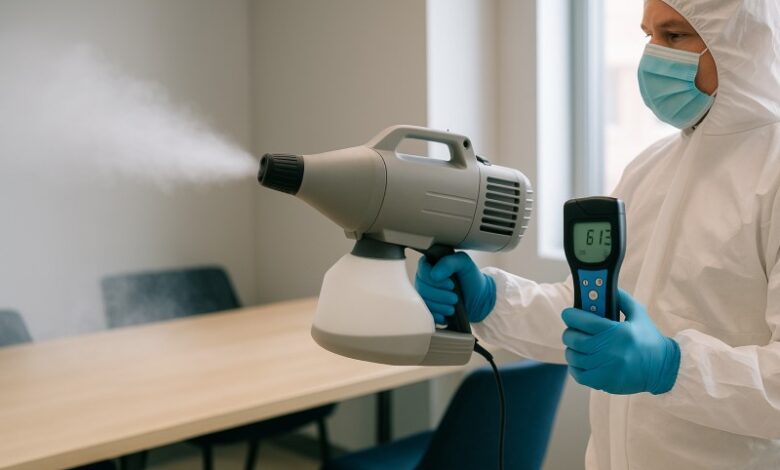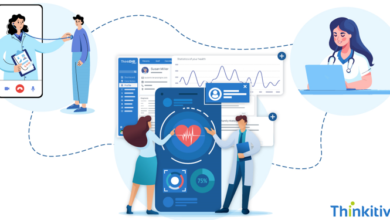Disinfection Services Done Right: The Role of ATP Testing and Fogging

Disinfection is vital in many commercial and public sector settings. How does ATP and fogging help in regard to infection control? Read on to find out.
Understanding ATP Testing and Why It Matters in Hygiene Control
ATP (adenosine triphosphate) testing is one of the most effective ways to assess hygiene standards in commercial environments. ATP is present in all organic matter, including bacteria, food residue and biological contaminants. When surfaces are swabbed and tested using a handheld device called a luminometer, the amount of ATP present produces a measurable reading. Higher levels of ATP suggest that cleaning has been insufficient, even if the surface appears clean.
In kitchen settings, this is particularly important. Food preparation areas can harbour dangerous contaminants if surfaces, handles, or equipment are not properly sanitised. ATP tests highlight exactly where cleaning falls short, providing rapid, science-backed insight into hygiene levels. It’s a step beyond visual checks or basic wipe-downs, giving business owners and facility managers real confidence in their cleaning routines.
While ATP testing is widely used in hospitality, it’s increasingly being adopted in offices, schools and other shared environments. From keyboards to countertops, ATP levels reveal hygiene blind spots that may not otherwise be addressed. For businesses looking to improve standards or prepare for inspections, testing ATP levels offers quick, quantifiable results that support better cleaning decisions.
The Role of Disinfection in High-Risk Environments
Professional disinfection services are essential in high-risk spaces where cleanliness directly impacts health and safety. In commercial kitchens, routine cleaning may not be enough to remove harmful pathogens from high-touch or hard-to-reach areas. Professional disinfection uses proven techniques and approved cleaning agents to eliminate bacteria and viruses that traditional methods may leave behind.
For example, disinfecting fogging methods are sometimes used after outbreaks or deep cleans to ensure that every surface, even those which are usually out of reach, receives an even layer of disinfectant. While this is often seen in offices and schools, it also has practical applications in kitchens, especially in preparation areas with complex equipment layouts. Though not a daily requirement, fogging provides an added level of protection when circumstances demand it.
Professional disinfection complements ATP tests by ensuring that cleanliness is not just assumed, but verified. Whether you’re operating a hotel kitchen, managing a school canteen, or maintaining hygiene in a shared office, professional disinfection makes a measurable difference. It supports public health, reduces absenteeism and gives management peace of mind that cleaning routines are effective and fit for purpose.
How ATP Tests Support Hygiene Audits and Compliance
Environmental health officers expect businesses to prove their hygiene protocols are effective, especially in food preparation zones. Helpfully, testing for the presence of ATP provides objective, measurable data that can be used to support audit readiness and ensure ongoing compliance with industry standards.
Key advantages of ATP tests are their speed and simplicity. Within minutes, staff or cleaning teams can identify whether a surface has been adequately sanitised. This is particularly helpful in fast-paced environments where deep cleaning must be done quickly between service periods or shifts. By incorporating ATP tests into other regular workplace routines, businesses can pinpoint weak spots before they become compliance issues.
Beyond food preparation businesses, ATP tests are equally relevant in schools and offices, where cleanliness impacts staff and student wellbeing. It’s a powerful tool for facilities managers looking to raise hygiene standards or address complaints. Used as part of a documented hygiene strategy, ATP results create a valuable audit trail, one that can reassure inspectors, landlords and other stakeholders that a building is being maintained to a professional standard.
When to Use ATP Tests Alongside Fogging or Deep Cleaning
Testing for ATP works best when it’s part of a broader hygiene programme that includes professional disinfection. While testing alone provides valuable insights, pairing it with targeted cleaning or fogging ensures you not only identify contamination but also eliminate it effectively. This is especially important after a suspected outbreak or in areas with persistent hygiene concerns.
Deep cleaning of kitchen extraction systems, equipment or worktops is often followed by an ATP test to verify that the space is ready for safe use. In some cases, such as after Norovirus exposure in a school kitchen or post-COVID sanitisation in an office, for instance, antiviral fogging may be deployed to treat high-risk zones. Testing before and after this process provides reassurance that cleaning has been both necessary and successful.
Routine ATP tests are also useful between scheduled deep cleans, helping managers decide when extra disinfection is required. Rather than cleaning to a set timetable alone, facilities can respond to actual hygiene levels. This responsive approach makes cleaning more efficient, cost-effective and aligned with best practice. It also ensures that disinfection resources are focused where they’re needed most.
What to Look for in a Disinfection and ATP Testing Provider
Not all cleaning providers offer disinfection or ATP services. Fewer still deliver them to a professional standard. When choosing a contractor, it’s important to look for experience in your sector, whether that’s commercial kitchens, schools, or multi-use buildings. Providers should be fully trained, COSHH-compliant and able to supply documentation that supports audits and inspections.
The right provider will not only carry out ATP tests and fogging correctly, but also advise you on how often these services should be used. They’ll help identify priority areas, set benchmarks and recommend a cleaning strategy tailored to your site. Flexibility is also crucial. In foodservice environments, cleaning often needs to happen outside of opening hours to avoid disruption.
Reliable providers also offer national coverage and consistent service across multiple sites. For businesses operating kitchens in several locations,this makes long-term planning much easier. Ultimately, a good disinfection partner provides more than just cleanliness. They deliver trust, transparency and the assurance that your hygiene standards are backed by data and not guesswork.
In summary, ATP tests, when combined with professional disinfection, provide measurable reassurance that hygiene standards are both effective and inspection-ready. Providers which offer both types of services can help businesses and organisations maintain compliance, reduce risk and create safer, more hygienic environments for all.



